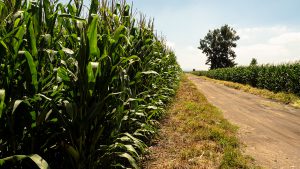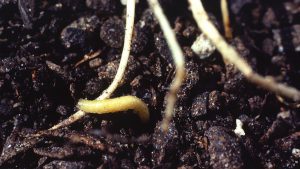Field observations
SUMMER 2021
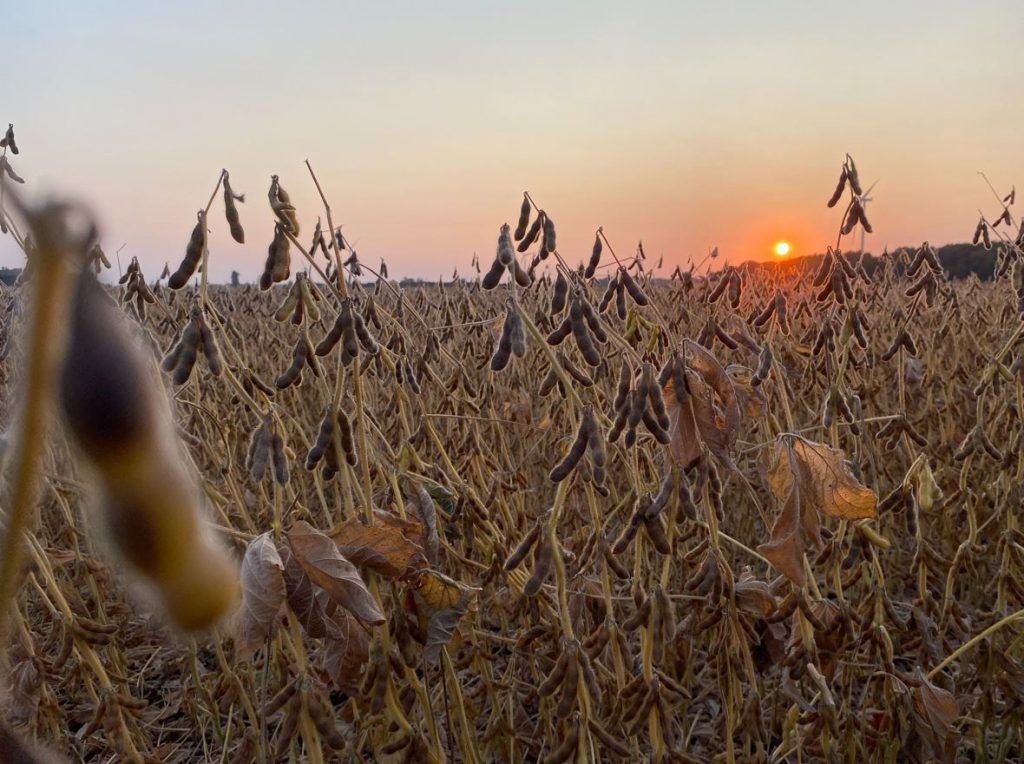
September 17, 2021
Corn and soybean maturity is moving along much earlier than the last number of years. Soybean and even some corn harvest has begun with early maturity varieties and hybrids. Earlier maturity allows farmers to be more selective with field operations and allows for the time required to harvest at ideal moistures and plant wheat in best soil conditions to achieve uniform wheat stands while avoiding soil compaction and wheel ruts. Looking at the long-range forecast, it appears much of the province may have hit and miss harvest opportunities in the next two weeks, but since we are earlier this year, we have the ability to choose the right window for field operations.
Corn
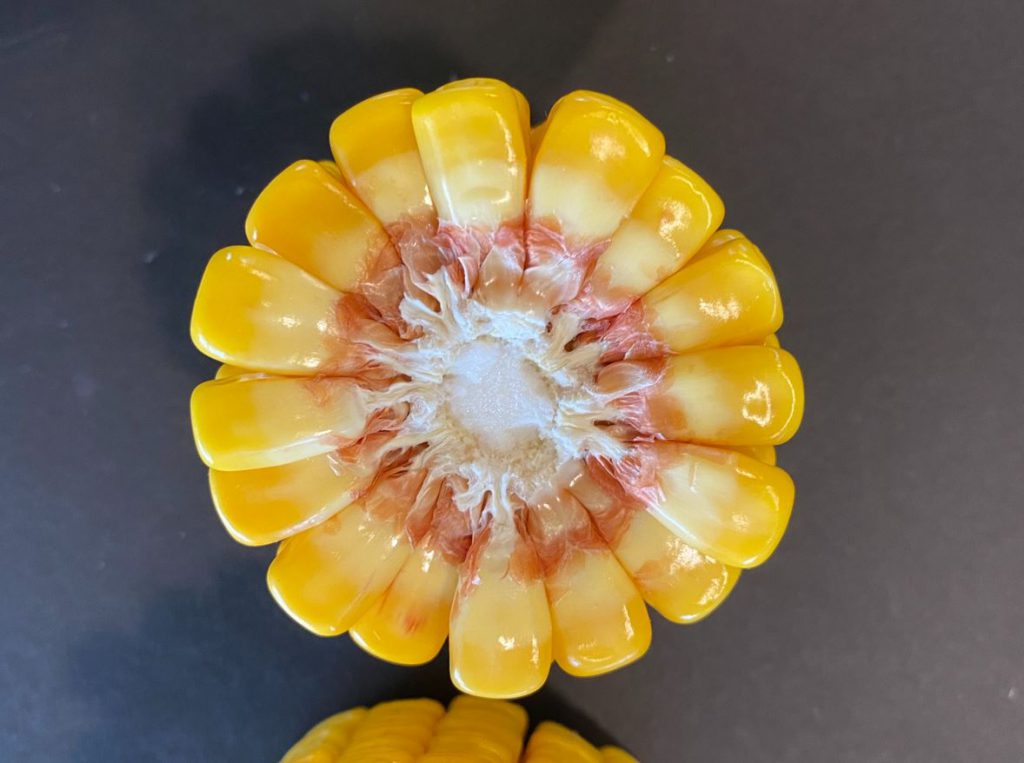
Milk line disappearance has moved quickly this week, with many fields well past the half milk line with some early fields reaching black layer (physiological maturity), 32 per cent moisture.
If plants die due to frost or disease at this stage (prior to black layer), up to five per cent yield loss could be possible and only take a little test weight off the top as kernel tips will shrink. As shown in the kernel dissection, lots of starch has been formed in the top and centre of the kernel, only the kernel tip is still soft. Killing frost or disease death before true black layer (milk line at 100 per cent) that kills the entire plant causes concerns with grain dry down as grain does not have the abscissions layer to block migration of moisture in the kernel. If grain is at early dent (milk line not formed) and plant dies, yield losses could be between 15 per cent to 25 per cent depending on grain stage and severity of damage. In this situation, grain quality will be poor with immature grain and harvest and storage will be difficult. Alternative harvest options should be sought. Since most of the corn in Ontario is nearing black layer, it is not expected many fields will be in danger this fall, but that said, if disease was severe enough and early enough there maybe a concern on poor quality grain that may be more difficult to harvest. Set the combine appropriately to remove all the grain off the cobs when conditions are drier.
Healthy corn plants will help finish the 50 to 80 per cent milk line kernels. Really good kernel depth and hard dense starch packed into the kernel will add kernel weight to maintain maximum yield potential in this field.
Tar spot is showing up more in Ontario fields, it appears to be showing up on plants that have not had a fungicide applied as well as those that have, although with less pressure on those that have. As the disease blows in, it will affect numerous fields, those fields that had the disease last year and are corn on corn may see an increased infection rate. In general, the disease showed up later this year impacting yield less. Although, now with drier weather in some areas, and tar spot or other diseases being present, the plant will shut down faster. The better the plant health, the more the corn plant is taking advantage of and able to put energy into the kernels for longer.
Soybeans
A few fields of soybeans have been harvested this week. With lots of fields maturing across Ontario it is expected that with the favourable forecast, harvest will be in full swing by next week. Make sure that your residue from the combine is evenly spread across the field to ensure ideal wheat planting conditions.
L to send so pic
Wheat
Winter wheat planting has started on some early open ground after edible beans or canola. As soybeans harvest gets into full gear next week, we will see a large amount of the winter wheat acres seeing a very timely planting window this year. Planting into ideal conditions will help farmers maximize their yield potential. Be sure planters are set for the field conditions, check regularly – especially when starting a new field or when field conditions change. Ideal planting depth is 1” to 1.5” to ensure root development is in the ground and prevents easy spring heaving of seedlings when seeding is too shallow. Seed placed phosphorus (P) is well worth your investment. Having P in the row helps with making more nutrients available at the seedling stage when the crop is getting established. Ensure that proper seeding rates are being used for early planting, optimum, or late planting. Aim for 1.6 million seeds per acre at the optimum date for each region. If planting before the optimum date, reduce rates by 100,000 seeds per acre per week. If planting past the optimum planting date, increase the rate by 100,000 seeds per acre per week.
Many regions of Ontario have received timely rains when needed throughout the growing season. Although some areas of Canada are still in desperate need of some moisture. See more drought details here.
September 3, 2021
Heat rolled into the province at the end of August helping to advance crop maturity quicker than most expected. Corn is now at the R5 (full dent) stage with grain in the 1/2 to ¾ milk line. Soybean fields have turned colour and leaf drop has been quickly advancing in the first week of September. Timely rains are still good for corn with green leaves as the plants are still producing sugar and packing on kernel weight. A good week or so of ideal conditions, along with healthy plants, will give added yield through deeper kernels and better test weight. Double crop beans planted in July are still green and will continue to develop through the month of September.
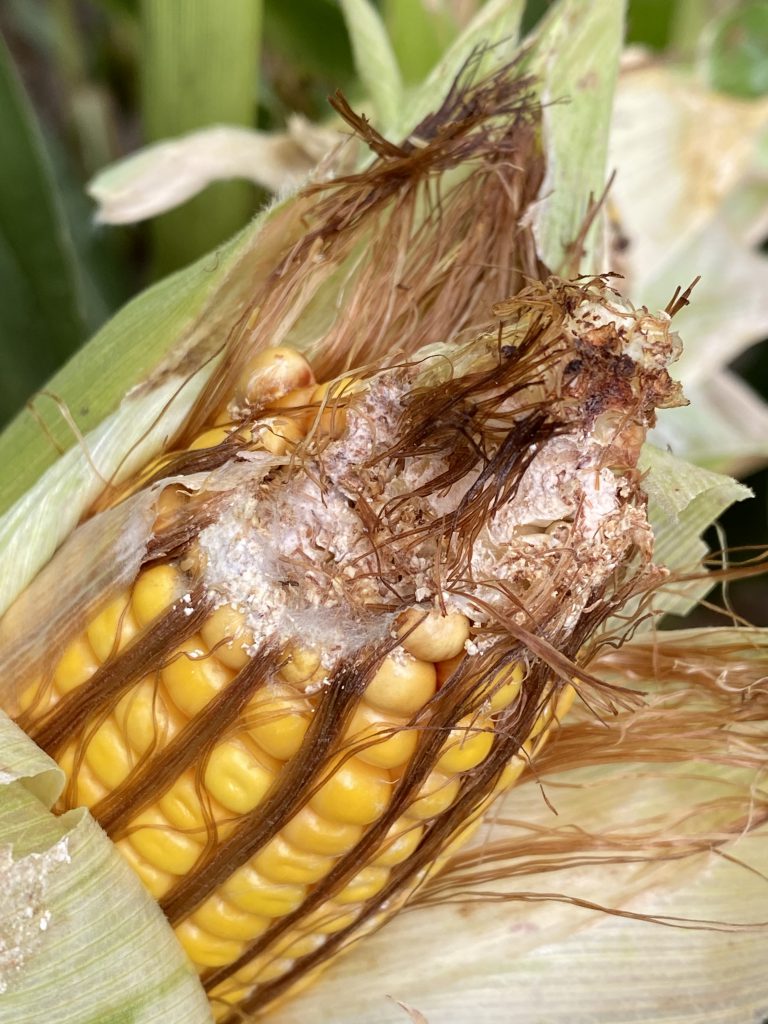
Corn
The heat at the end of August and beginning of September helped the corn move along towards full dent (R5). Corn has formed the milk line, which is the transition line between the milky layer and the harden starch layer. Lots of corn is in the 1/2 to 3/4 milk line. Corn husks are starting to senesce (turn brown) as the grain is reaching maturity. We can expect mature corn, which is corn that has reached black layer in about one to two weeks depending on the heat and stresses the corn plant is exposed to. With timely rains across most of the province, corn that was showing some moisture stress through the extreme heat wave in late August was able to receive a bit of relief and was able to turn the heat and sunshine into more energy and dry matter (yield).
Some insect feeding is being found in corn. At fungicide timing, it is advised to only spray an insecticide if the insect threshold and insect stage of development is reached. This year the timing of fungicide to control gibberela ear rot was ahead of when insect thresholds may have been reached. We are now seeing some increased insect pressure in areas as thresholds earlier did not warrant a spray. Ear moulds are possible on corn that has had insect feeding, leading to fusarium and then DON potential. For more information on when peak flight was for WBC and more on this past season, please visit: https://fieldcropnews.com/2021/08/crop-report-august-25-2021/
Northern corn leaf blight has taken off again as rainstorms have helped move spores and ideal conditions have allowed it to spread. Earlier fungicide applications have kept most of the corn clean with unsprayed fields showing the worst infections. Tar spot is spreading in Ontario and farmers are advised to scout and be aware of the disease in their area. Our 2020 Agronomy Alert provides helpful information around tar spot: https://gfo.ca/wp-content/uploads/2020/11/Agronomy-Alert-Tar-Spot-web-11-5-2020.pdf
The longer the corn plant’s leaves can be kept green the better the grain fill in the kernels. This leads to deeper kernels and better test weight resulting in better yields.
Soybeans
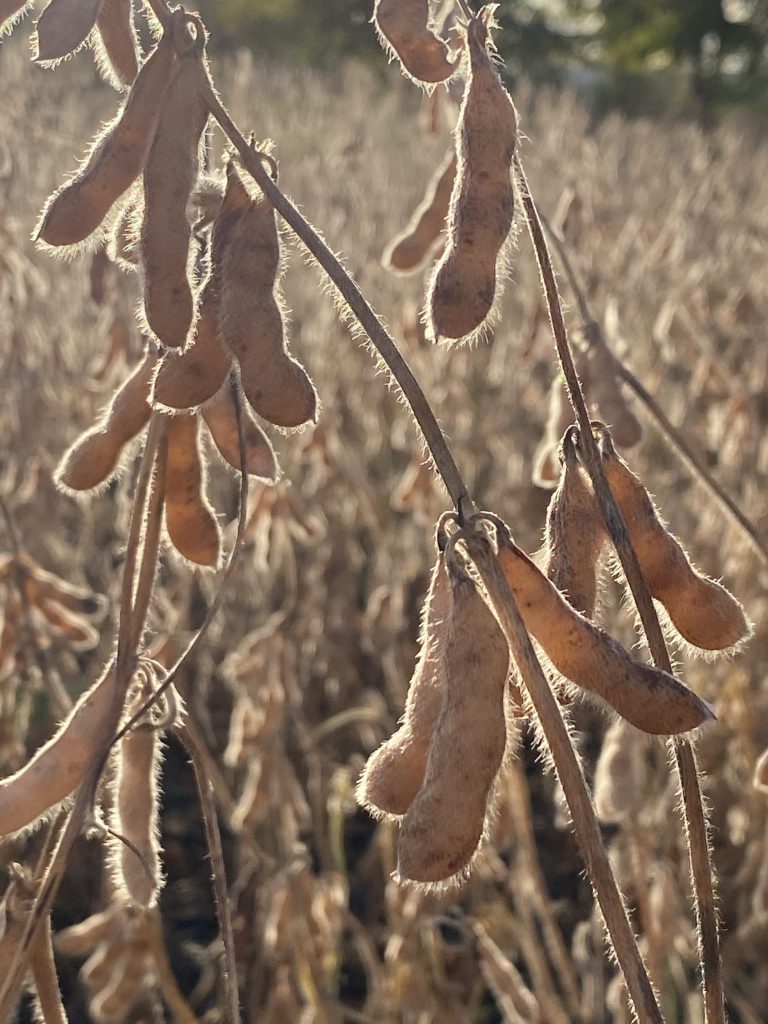
Soybeans have turned yellow with leaf drop occurring quickly as fields are at the maturity (R7) stage. Combines have been out this past week harvesting early maturity fields. Uneven field maturity that was noticed over the past few weeks is an indication that not everything is uniform in the field. Low spots could be greener due to less stress from more moisture available during the growing season or they could be delayed spring emergence due to not enough moisture at planting, leading to delayed plant development.
Areas of fields that are turning yellow quicker than other areas need to be investigated, as it may be an indication of disease or insect pressure. Possible concerns include soybean cyst nematode (SCN) populations in the soil or late season root rots. Moisture deficits due to spring compaction may be an issue to look out for. Scouting never stops and finding out the cause of the problem as soon as you see it is important. Trying to diagnose leaf, stem, or root issues will be difficult at harvest. Proper identification of problems will lead to better management of the field in future years.
Fields that have not started to mature are most likely double crop beans planted in July, in which case they will be maturing in October. Timely rains on the green fields will continue to keep the soybeans growing and putting on seed weight and yield.
Wheat
As winter wheat planting approaches consider the follow key points:
- Earlier planted wheat with good conditions will tiller more in the fall making a larger denser canopy
- Denser canopies with heavy snow loads can be the right conditions for snow mould
- Early established stands of winter wheat with ideal conditions will attract insects
If planting early, reduce the seeds per acre as fall tillering will be inevitable.
Check the seed size of the seed you are planting (on the bag tag) and adjust planting rate to hit the targeted population.
Scout wheat fields as plants develop and start to assess crop for possible adjustments in your crop management plan. Nitrogen application rate and timing in the spring needs to be based on needs and demands of the crop. Use a fungicide application to control disease pressure under dense canopies.
The rewards for early planting can be great if the crop is managed correctly through all stages.
Early planting is considered two weeks before optimum planting date. Be sure to make changes when planting earlier than optimum. Optimum winter wheat planting dates can be found here: http://www.omafra.gov.on.ca/english/crops/field/news/croptalk/2019/ct-0919a4.htm
August 27, 2021
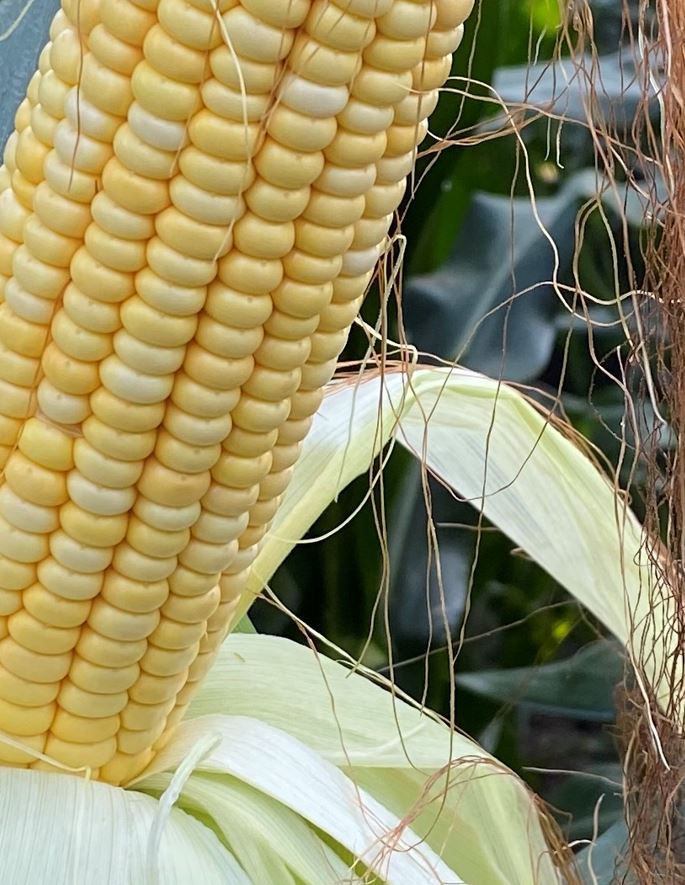
As the summer comes to a close, it certainly does not feel like September is around the corner with the high heat and humidity felt across most of the province this week. Soybeans and corn are advancing rapidly. Corn is starting to dent and with this heat will reach physiological maturity in the next three to four weeks. Soybeans in some areas are beginning to turn colour as they approach the R7 stage. Disease is showing its results with dead plants showing up in fields as maturity of the crop progresses.
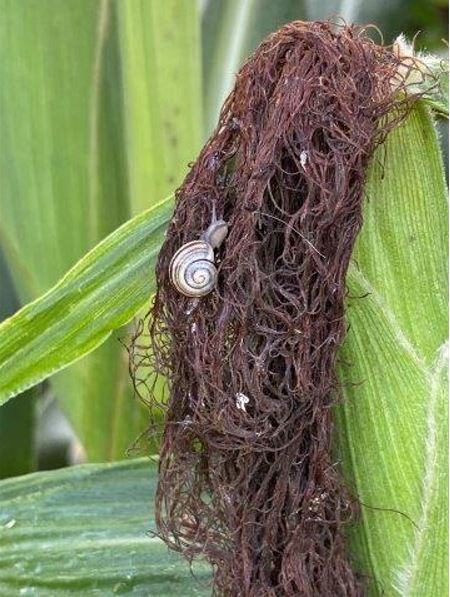
Corn
Corn is now starting to form a visible milk line as it hits the R5 (dent) stage, while many other later pollinated hybrids are in the R4 (dough) to early dent stage this week. September will see rapid movement of the milk line as the corn plant closes in on R6 (physiological maturity -black layer) in the next three weeks. Currently, this is the critical grain fill period for the corn crop when the plant focuses all its energy on filling the kernel. The depth and weight of the kernel will be determined over the next three weeks. Maximum sunlight (solar radiation) and adequate rainfall (moisture) will provide the crop the best opportunity to fill the kernels with starch.
The milk line of the corn kernel is the line on the kernel where the hard starch meets the milky wet part of the immature kernel. The milk line will continue to progress to the tip of the kernel as the corn produces more starch and packs it into the kernel. Once the milk line has reached the kernel tip (sugars converted to starch) then the kernel is full and the black layer is formed, which restricts transfer of starch.
Soybeans
Some earlier season soybeans are turning (it seems early in general!). Stages for soybeans across the province range roughly from R5 (beginning seed) to R7 (beginning maturity). Patches in fields may be seeing some early maturing soybeans, not because of the maturity level, but because of compaction at planting time or ponding during the growing season. These soybeans are shutting down early due to lack of root development and available soil moisture in the root zone.
For the soybeans that are edging closer to maturity, the pods don’t seem as full as they could be, with not a lot of pods on the bottom of the plant. Over the growing season there has been a lot of vegetative growth; but once into the canopy to look for pods and bean counts, some of the lower branches aren’t podded like other years. As drier and hotter weather has moved in, more of the smaller pods have been dropped from the plant as the plants main goal is to fill the current pods, so excess pods will be lost during periods of stress rather than continue seed formation. Not all is lost as having limited pods and seed will mean that if rain does come in timely, the plant will continue to fill the remaining seeds and seed size will be larger.
There is still a lot of disease being found in all crops in the field. Sudden death syndrome (SDS) is one that seems to be popping up more in fields that may not have seen it before. Characteristics of SDS are random plants dying throughout the field. If you dig up the plant and split the stem, the pith (middle of the stem) will be white while the roots may be rotten. More info can be found here.
Cereals
Spring cereals are currently being harvested.
The Ontario Cereal Crop Committee (OCCC) conducts variety performance trials to determine the genetic potential and adaptation of cereal varieties in the province of Ontario. Results of the 2021 winter wheat trials are now available on www.gocereals.ca under the ‘Performance’ heading at the top of the page. Grain Farmers of Ontario supports these trials across the province.
It will soon be time to plant winter wheat, if you are using your own seed or receiving certified seed, be sure to check seed counts, as there has been discussion that the seed this year is smaller than in past years.
August 20, 2021
Humid conditions in southern Ontario with frequent foggy mornings have increased leaf wetness and created ideal disease environments within the growing crops. Stressed and weaker plants will be subject to disease infections. Diseases such as sudden death in soybeans, along with tar spot and northern leaf blight in corn, will be thriving in fields where infections are present.
Corn is filling out the kernels as it is at the dough stage. Early denting is occurring on the early crop. Soybean pods are filling out with seed. As we have reached the last month of crop development, everything we did to get the crop here has protected our yield potential, it will be up to the late August and early September weather to drive this crop home in this last stretch of the season.
Corn
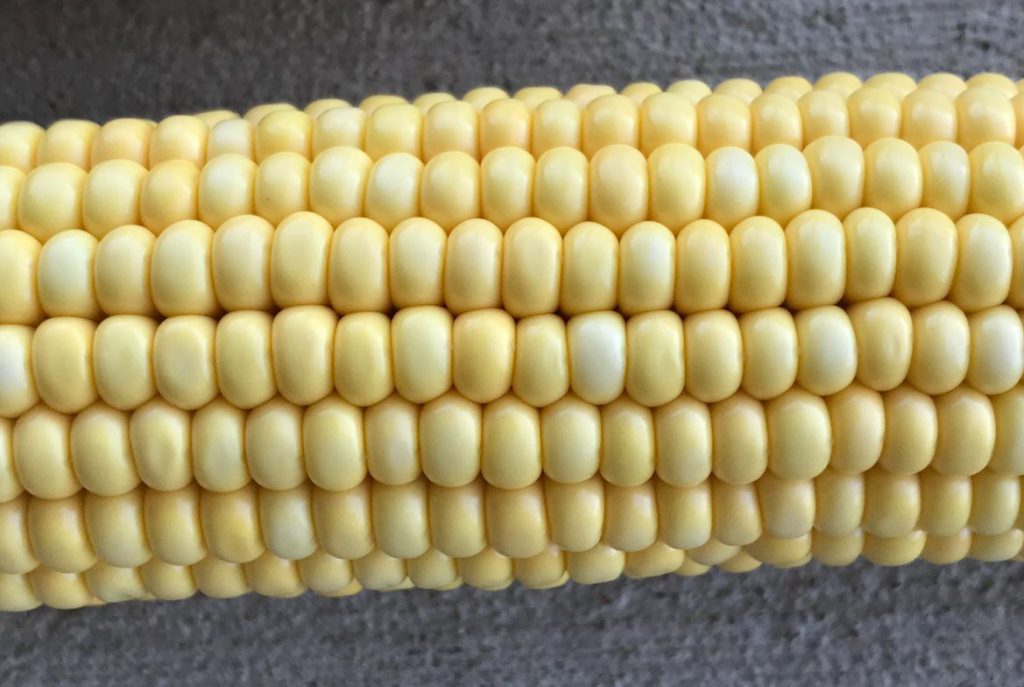
Much of the province’s corn is in the R4 (dough) stage this week. The one ear is showing some denting as we are just a few days from the R5 (dent) stage. There is no milk line showing yet, so corn is not officially at R5. In the coming days, the milk line will appear as it has been about 30 days since pollination. In another 30 to 35 days, we will be at black layer which is when the crop is physiologically mature and will be safe from any frost threat..
Corn in many areas is looking quite good. Although there is certainly variability across the province. Areas that have not received enough rain, or that are on lighter soils, or saw too much rain, are showing some signs of stress and unevenness with bottom leaves yellowing up.
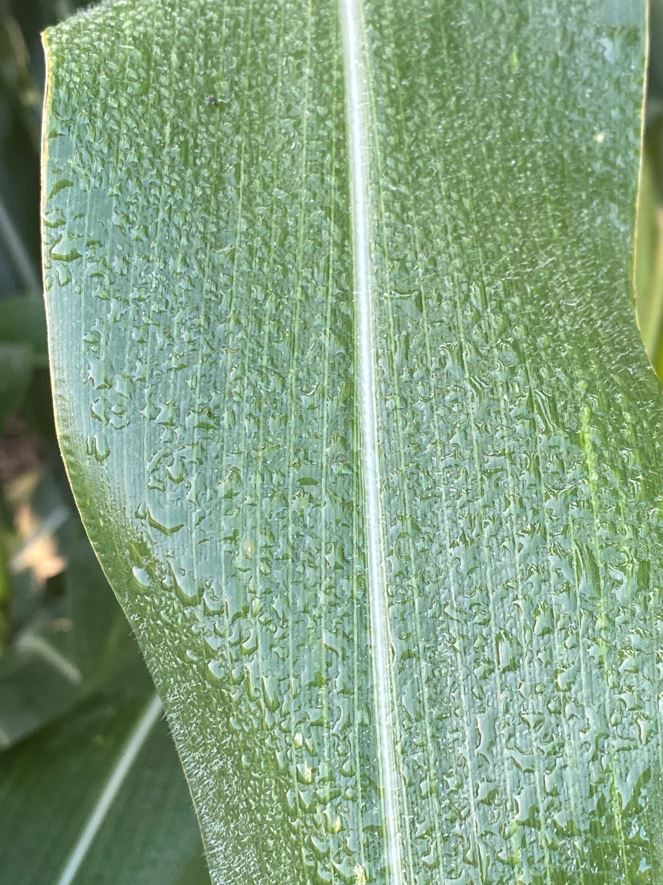
You may have noticed on some stalks a second cob, especially on the outside row. These cobs may look pollinated but there will be very little kernel development when plant populations are high. With the corn field at higher populations the corn plants will be under enough competition for resources that it will cannibalize the second cob, putting the energy into the main cob. Along the edge of the field, the secondary cobs may develop a smaller cob with grain as there is less plant competition, this is referred to as the edge effect. Always walk into the main area of the field to get a good representative sample of plant development.
Tar spot has been increasingly found this season in Ontario, as could be expected with our ideal weather conditions of frequent rainfall, humidity, and warm temperatures as this helps the development and spread of the disease. Essex, Chatham-Kent, Elgin, Lambton, Middlesex, and Norfolk have been confirmed with fields infected with tar spot to date.
Soybeans
Soybean pod clusters are showing up nicely this week. Many fields are in the R5 (beginning seed) to R6 (full seed) stage as the pods near the top of the plant are filling out. As the plant reaches this maturity point, flowers will be harder to find, with the plant now more focused on filling the pods. Sunlight and good moisture conditions over the next few weeks will help size up the soybeans and help keep the plants from aborting too many pods. If you are finding pod clusters with three-bean pods, it may be a sign of limited stress.
There are some fields of uneven beans out across the countryside. This is mainly due to compacted soils and excess water stress earlier in the season. Scouting this week should target identifying soybean diseases as control and prevention is no longer an option. Identification can help with understanding what disease is robbing your yield and potential changes that can be implemented in future years. Sudden death syndrome has been found in areas not previously of concern and should not be confused with brown stem rot or dead plants caused by white mould.
Also, watch for weed escapes. Are the weeds in your field needing to be dealt with still? If growing IP beans you certainly don’t want volunteer corn in your sample or staining from nightshade. Be sure to have a plan as harvest approaches. If you think you may have some resistant weeds, take note, and make plans for future herbicide applications.
Spider mites are showing up in fields. Be aware that sometimes infestations are misidentified as drought stress – be sure to walk fields and look. Tracey Baute, field crop entomologist with the Ontario Ministry of Food, Agriculture and Rural Affairs, is looking for samples to test for dimethoate resistance, please contact tracey.baute@ontario.ca if you find any in sprayed or unsprayed fields.
Cereals
The Ontario Cereal Crop Committee (OCCC) conducts variety performance trials to determine the genetic potential and adaptation of cereal varieties in the province of Ontario. Results of the 2021 winter wheat trials are now available on www.gocereals.ca under the ‘Performance’ heading at the top of the page. Grain Farmers of Ontario supports these trials across the province.
August 13, 2021
It was another interesting week of weather across the province – high heat, lots of storms scattered across the province, and northern Ontario is still dealing with a terrible drought. If only we could have the rainfall uniformly deposited across the province, the average of the combined would be best for all farmers. Corn and soybeans in areas with timely rains are looking exceptional. An average rain every week would continue peak crop development and maximize yields.
Corn
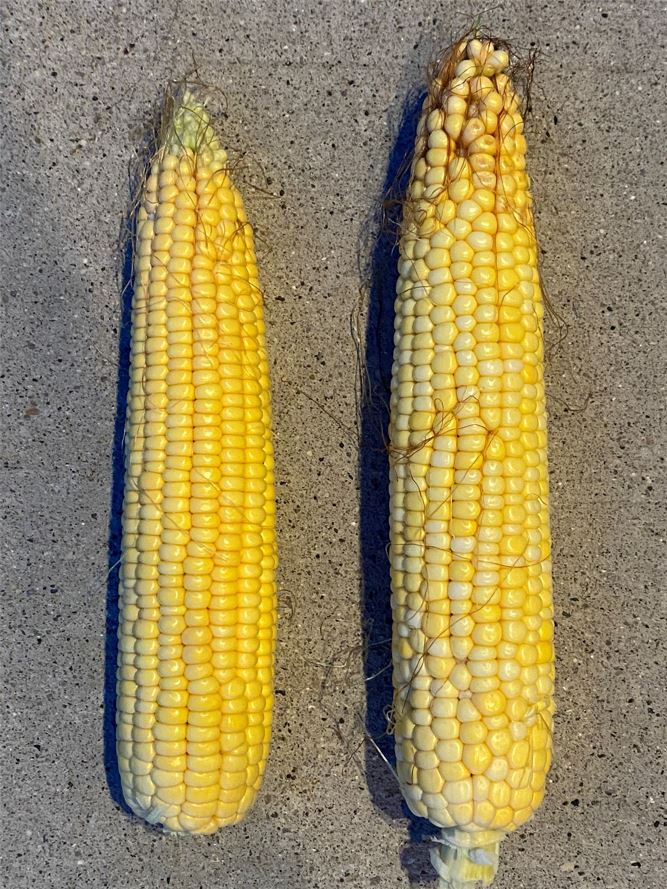
Corn is now in the R2 (blister) to R3 (milk) stage which is a great time to evaluate pollination. Peel back some husks and see how the ovules are developing. Some notes to make are to assess how many missed kernels there may be and where they are on the cob. The bottom of the cob is the first to be pollinated; as those silks emerge first, they will be the first ovules to be fertilized and may be more developed than the others near the tip. If you notice that the tip of the cob has no ovules developing and green silks are still attached and there is no pollen left on the tassels, this signals that pollen was no longer viable by the time the tip silks emerged from the husk. If there are pollinated kernels missing at the bottom of the cob, that would signal that potentially the silks emerged well before the pollen began to shed and became too long for the pollen to effectively travel down the silk to pollinate the ovule (damaged silk tubes etc). Sporadically missed kernel pollination on the cob could be independent challenges of that specific silk channel as the transporting of the pollen grain to the ovule was impeded. If one side of the cob is not pollinated, typically referred to as zipper cob, this can be caused by severe drought, severe defoliation, or severe nutrient deficiency problems around the pollination time.
In the areas (eastern Ontario) that have experienced drought stress on their crops prior to receiving some timely rains, the plant stature is shorter, and In the areas (eastern Ontario) that have experienced drought stress on their crops prior to receiving some timely rains, the plant stature is shorter, and the bottom internodes are abnormally short on the lower half of the plant with larger internodes above the cob. This would indicate stress at the V5 to V8 stage, and better growing conditions afterwards. Ear husks tend to be short on plants that have been stressed due to drought, with many ears with exposed tips. Drought conditions shorten the husk development, and later rains allow for ear length to extend longer than normal. The exposed tips are detrimental, as insects and birds will eat the tips, and could allow for an infection point for ear moulds.
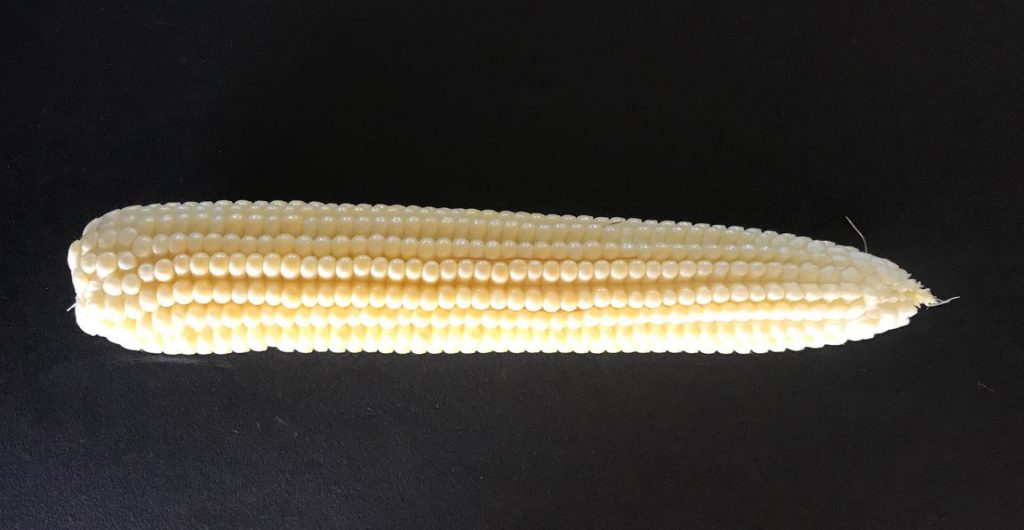
Corn rootworm hasn’t been a widely talked about insect this season, as others have taken the forefront so far, but now is a great time to get out scouting for this pest. Fields that have continuous corn, repeated use of the same rootworm BT traits, and fields that had high corn rootworm populations in previous years are high priority fields, as BT resistance may be found. CRW can clip roots, limiting nutrient and water uptake and can clip silks which can have an impact on pollination. Get out and look for these insects – ideally now, but certainly before early September. For what to look for specifically visit Field Crop News or read over our Agronomy Alert.
Tar spot has been spotted already this year, which is earlier than it was spotted last year. Find out more about this disease with our Agronomy Alert or here.
Soybeans
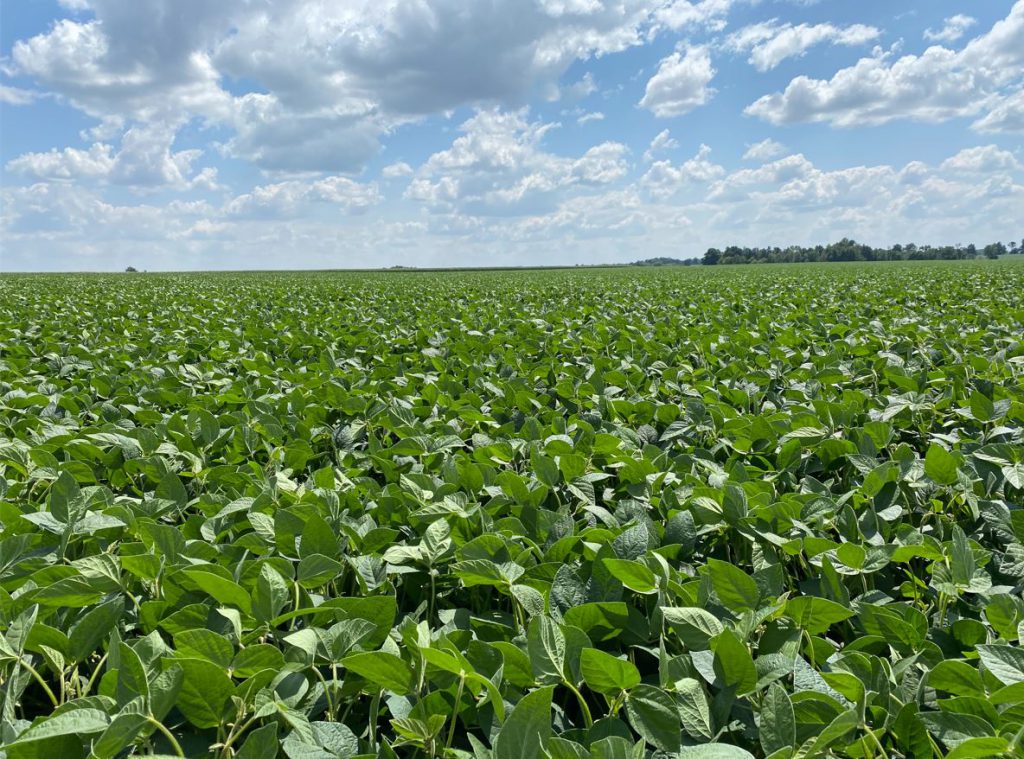
Through August, soybeans will require timely rains to help the development of the soybean seed and prevent drop in the seed count per plant. With many fields in the R4 (full pod) to R5 (beginning seed) stage extreme heat like some areas of the province experienced this past week can be detrimental to soybeans as the heat causes stress. Stress can encourage the plant to abort the top pods, along with any new pods forming. If moisture levels do remain where they are for the regions that have received rain more flowers are being developed on the plant, and full yield potential has not been realized yet. With adequate soil moisture this month, seed count and sizing should be good.Through August, soybeans will require timely rains to help the development of the soybean seed and prevent drop in the seed count per plant. With many fields in the R4 (full pod) to R5 (beginning seed) stage, extreme heat (like some areas of the province experienced this past week) can be detrimental to soybeans as the heat causes stress. Stress can encourage the plant to abort the top pods, along with any new pods forming. If moisture levels do remain where they are for the regions that have received rain, more flowers are being developed on the plant, and full yield potential has not been realized yet. With adequate soil moisture this month, seed count and sizing should be good.
Many insects are still being found in soybeans; bean leaf beetles (feeding on pods of crush beans does not typically warrant control), aphids and stink bugs are making their presence known.
Heavy rains in areas have lodged some soybeans.This could increase disease presence on plants, so keep scouting. Keep an eye out for white mould in fields, proper identification is critical in managing any problem on the farm and confirming disease presence will allow you to manage harvest and make decisions to prevent the spread of disease or weeds to other fields.
Soybean Cyst Nematode (SCN) may be showing up in some areas. The impact is not always obvious in fields that are looking great, or those that have had ample moisture. But in poorer fields, and fields that have lacked moisture you may notice stunting, slow canopy closure, and chlorotic foliage in patches Find out more here.
Cereals
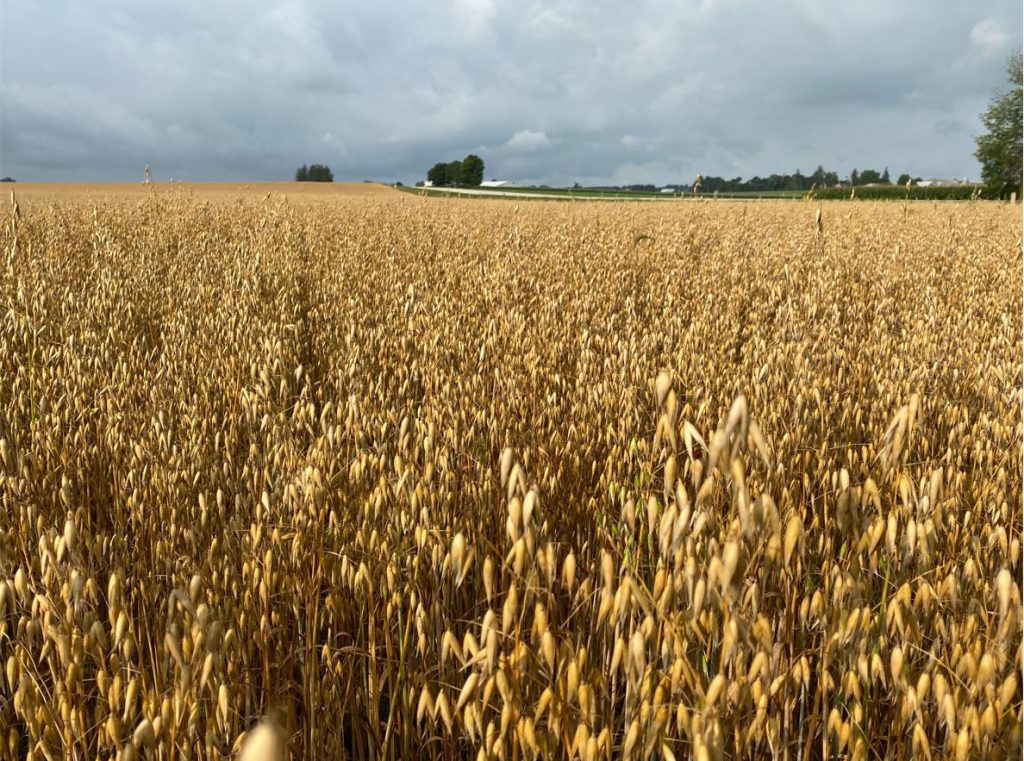
Winter wheat harvest is 90 to 100 per cent complete. For information on overall wheat quality visit Grain Farmers of Ontario Wheat Quality Survey.
Many fields of spring cereals in southern Ontario are approaching harvest in the next couple of weeks, when combines will be rolling again.
The drought in northwestern Ontario is still a very real topic, with conditions ranging from abnormally dry to extreme drought, causing cattle farmers to sell cattle as there is not enough feed. Grain farmers in northern areas of the province are in the midst of harvesting some spring grain, with yields being lower than average. See the Canadian drought map here.
August 6, 2021
It has been another week of wacky weather. Forest fires are spreading in northern Ontario where it is still extremely dry; eastern and central Ontario fields are still in need of some rain; hail in some areas shredded corn leaves; and for the rest of the province, there has been a little less rain that has fallen, allowing for wheat harvest to continue. Rain will be needed regularly in August to help fill the corn and soybean kernels/seed. Continued dry weather will cause kernel/seed abortions in the crop at this time.
Corn
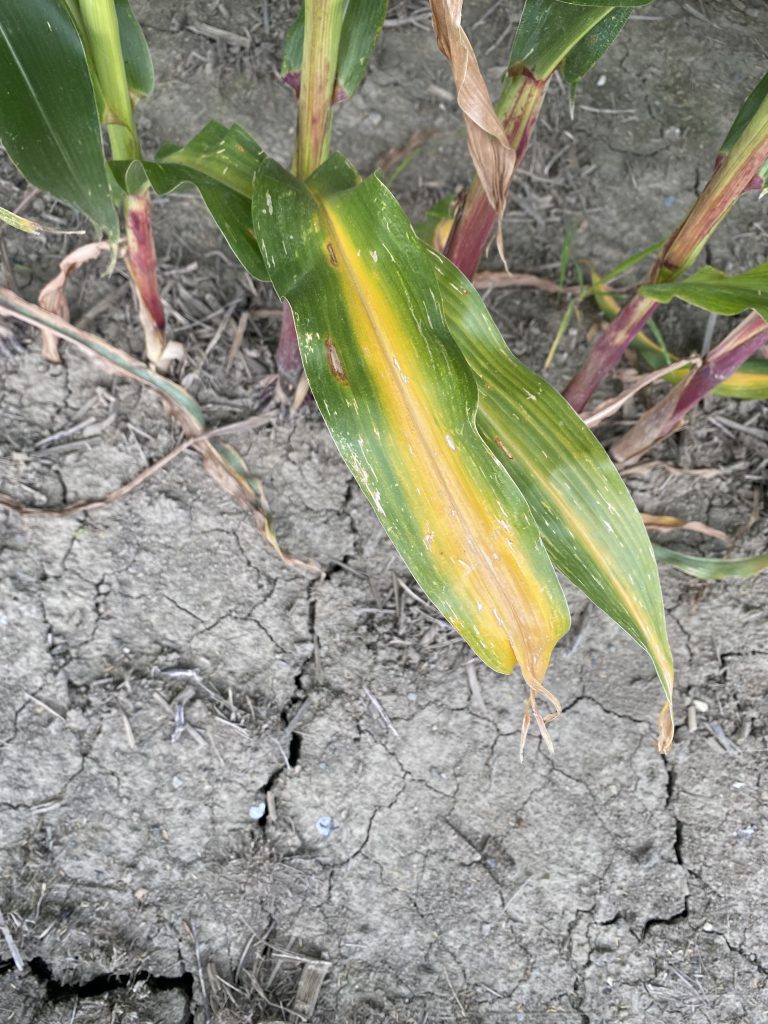
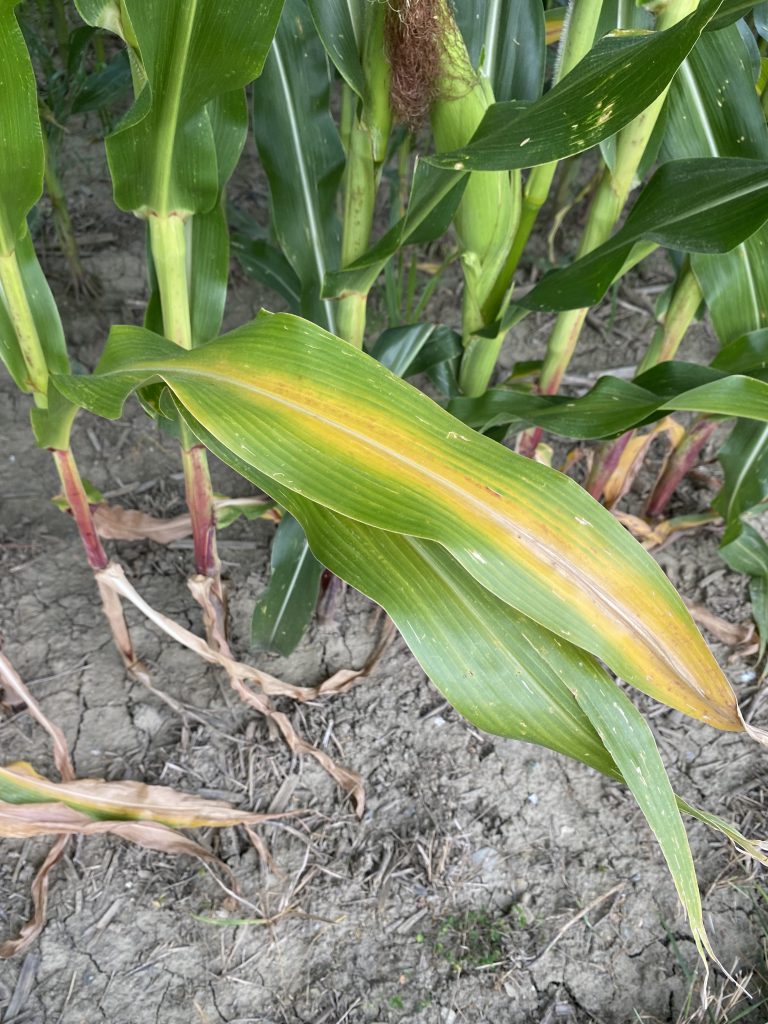
With corn pollination nearing an end across much of the province, corn is in the late R1 (silking) to R2 (blister) stage. With the R2 stage, it is time to do some pollination checks. Once dry silks appear at the tip end as brown silk, a quick husk of the cob and a shake of the cob can reveal the potential kernel count. Knowing the potential is good, but drought stress, nutrient loss, disease, and insect feeding can still cause kernels to be lost in upcoming weeks. It is always a great idea to keep track of weather patterns and temperature throughout the crop’s growth. It is interesting and sometimes valuable to look back and be able to target when certain stresses occurred; fewer rows on the cob could be from stress around the V6 to V8 stage when the cob is forming, and stress around the V8 to V12 stage can affect the kernel number per row. Kernel potential is set by V12 but is highly impacted at pollination and grain fill. Hence the potential of 900 ovels (18 x 50) on an ear at pollination can end up only being a 630 kernel cob (18 x 35) at harvest.
Some regions of Ontario have experienced an incredible amount of rain since nitrogen was applied. With these rainfall events, nitrogen(N) has leached deeper away from the root zone and is not accessible to the roots (coarser soils, tile drainage), or has been denitrified due to water saturated soil (heavier soils or undrained areas). As N is a mobile nutrient in the soil and in the plant, when soil N is limited, the plant will move N from the older, lower leaves and move N up in the plant where N is required in the growing points. The symptoms appear as a V shaped yellowing on the lower leaves, beginning at the tip of the leaf and moving down the leaf towards the stalk. N deficiencies can limit kernel development, and result in shallow kernels. It can also cause poor kernel set (poor pollination) and cause the kernels to abort at the tip of the ear. Grain Farmers of Ontario has in the past supported some research on N management in corn and how rainfall and temperatures impact N https://gfo.ca/research-projects/c2015ag13/. Also a past project looked at moisture interactions with N on corn and N demand https://gfo.ca/research-projects/c2017ag01/. Currently another study is continuing to look at how heavy rains can affect N levels and availability to the corn crop.
Western bean cutworm (WBC) peak flight via the trap network is showing that peak flight has most likely happened over the last week to 10 days. The ideal time for control was over the peak flight timing.
Soybeans
Soybeans are in the R4 (full pod, ¾” long at one of the four uppermost nodes) to R5 (beginning seed, seed 1/8” long in a pod at one of the four top nodes on the main stem) across much of the province. In areas where drought stress had not aborted pods or flowers, pods are forming in nice clusters which should lead to good yields. In areas where there is stress, plants will have aborted or will be aborting flowers and pods which of course will affect final yield.
White mould is being spotted in soybean fields. At this point most soybean fields are well past the timing for fungicide applications for white mould or for late season disease. Plants that are affected by white mould will die, affecting yield. For future years the fungus survives in the soil for years after infection of the plant as sclerotia. No variety is completely resistant, but some are moderately resistant. Early planting, narrow row widths, and high plant populations allow for early canopy closure and support the disease. So, in future years keep this in mind. Crop rotation can also help, two to three years of non-host crop can help reduce the pathogen in the soil.
Other leaf diseases such as powdery mildew are still showing up in canopies. Sudden death syndrome and Soybean cyst nematode are also diseases to be on the look out for. Both can severely impact yield.
Cereals
Winter wheat harvest is nearing completion across the province with areas at 75 to 100 per cent complete. There are still reports of quality issues on wheat with sprouting and low falling numbers as a result. Try to get your wheat off as quickly as possible, as weather allows.
With winter wheat harvest coming to a close it is time to look towards the fall when winter wheat will be planted – selecting what variety of wheat is planted is a very important decision. Good variety selection allows for the opportunity for high yields. Ideally, choose a high yielding variety that has good disease and lodging resistance. More information on varieties can be found on the Ontario Cereal Crop Committee website. As harvest wraps up, the 2021 winter wheat performance report will be posted later in August. https://www.gocereals.ca/. Grain Farmers of Ontario supports the OCCC trials.
After wheat harvest is a great time to soil sample fields for nutrient content. Soil sampling falls under good 4R nutrient management. View our recent webinar on 4Rs and soil sampling here https://gfo.ca/webinar/graintalk-webinar-the-4rs/
For information on cover crop recommendations, the Midwest Cover Crop Council has a Cover Crop Decision Tool that has Ontario recommendations built into it. The tool was partly funded by Grain Farmers of Ontario.
If you are struggling with mental health due to drought, harvest concerns, or other issues, please speak with someone https://gfo.ca/farmerwellness/support-resources/
July 30, 2021
Another week of variable weather in Ontario. Warm, wet periods are making ideal conditions for disease development in the crops. Insects have also been causing some trouble in drier regions but can be found in all areas in varying populations. If you had moisture, crops are looking good; if you had too much rain, crops are looking stressed and are impacted by the hot dry periods. If you have not received rain, crops have shriveled up and will not be able to make grain.
There certainly are extremes this year. Whoever said, it will all even out in the end, wasn’t thinking of a specific situation like 2021. If you find yourself in an extreme area, it is tough, and situations seem impossible but please reach out, talk with others. Sometimes help comes from where we would not expect.
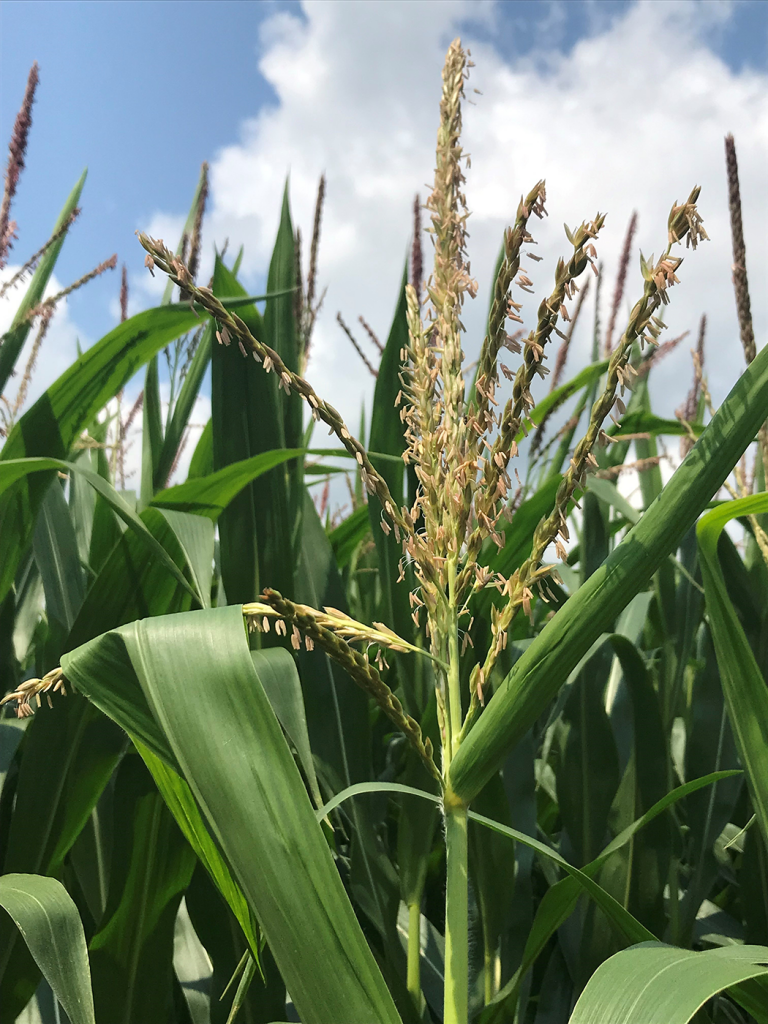
Corn
Corn has been under the sprayer the past few weeks during the period when silks are fresh. Farmers looking to prevent gibberella and fusarium ear rot have been watching the weather and managing their risk when the crop is in the ideal threat of temperature (27°C – 28°C) and humidity (rain, fog, saturated soil). Next week’s forecast of cooler and drier weather will reduce the infection potential on the later pollinating corn crop. Grain Farmers of Ontario supports an annual DON survey which takes place in late September. The survey will give a good indication of hot spots for DON accumulation throughout the province.
Western bean cutworm traps have shown an increase in catches this week and will likely see peek flight in the next few days. Insecticide applications should be timed to meet peek flight at the R1 (silking) to R2 (blister stage where kernels look like blisters with clear liquid). Insecticides can often, and should, be tank mixed with a fungicide to control later season diseases. If you have already sprayed a fungicide, be sure to follow the label instructions and limit the amount of a particular class of fungicide and switch groups to manage disease resistance.
Soybeans
Soybeans in general look good, but there is the range this year from too wet to too dry. Most soybeans are in the R3 (beginning pod, 3/16” pod on the four uppermost nodes on the main stem) stage to R4 (pod 3/4 “ long on one of the four uppermost nodes on the main stem).
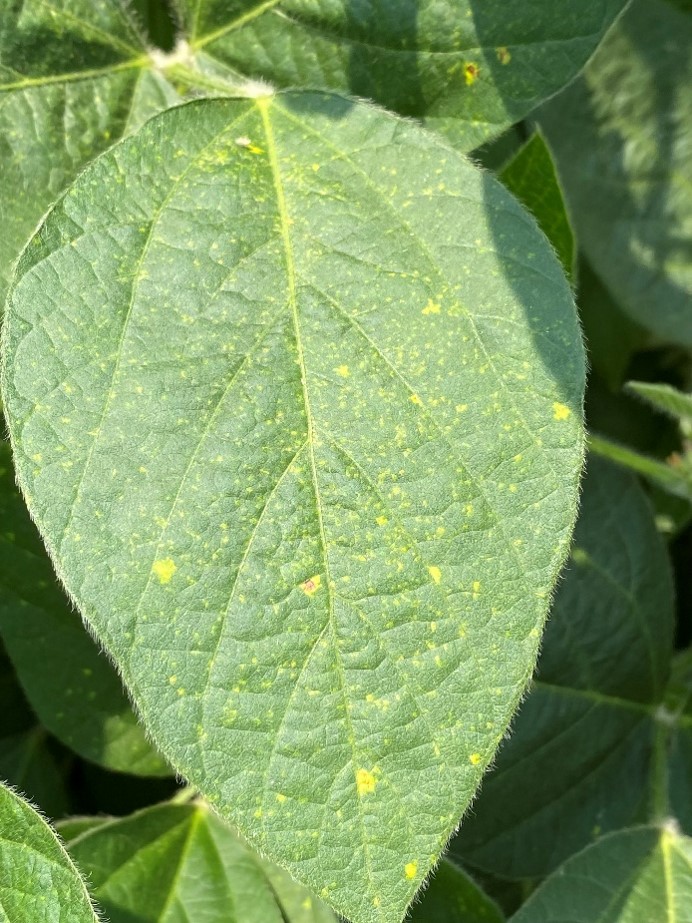

White mould is showing up in soybeans already. White mould is caused by the pathogen Sclerotinia sclerotiorum. Fields with dense canopies that have experienced rain, fog, and dew during the flowering stage may see higher rates of white mould infection. Fields that have been infected with white mould in the past are certainly more prone to infection as the black sclerotia (looks like mouse droppings) overwinters in the soil and produces fungal spores when the temperature and moisture is right for infection. Symptoms from white mould can be seen after flowering by looking into the canopy and looking for the white mycelium on the stem. In the upcoming weeks dead plants will be observed in fields.
Fungicide applications for white mould can be made in soybeans ideally around R1 to R1.5, just before full flower and pod set. Fungicide applications made around the R3 stage are for protecting plants against late season disease.
Leaf diseases are being found in some fields due to the extreme weather conditions we are seeing. There are lots of different pathogens thriving under cool, humid conditions. Downey mildew is showing up as light green speckling on the leaf, check the underside of the leaf for tufts of spore bearing hyphae (looks like white fuzz). If no spores are present on the underleaf, then the speckle could be environmental – varietal interaction. Sudden death syndrome symptoms usually appear after flowering. Leaves show scattered yellow spots, which grow to large blotches of yellow and dead tissue between the veins, with the midvein and major lateral veins remaining green. If the stem is cut in half, the interior will be discoloured to a light grey/brown. Click here for more information.
Heavy rains during the reproductive stages can favour symptom development. Soybean cyst nematode and soil compaction can increase the incidence of the disease.
This year soybeans seem to be under attack by insects – aphids are spiking threshold in central and eastern Ontario and are needing to be controlled. Stink bugs are showing up in fields. They attack the soybean pod and suck up fluid from the developing seed, causing deformed and discolored seed. Stink bugs can be detrimental from R2 to R6. Bean leaf beetle and Japanese beetle can be found quite easily.
Cereals
Winter wheat harvest is now 75 to 100 per cent complete in areas. Some regions have experienced wet weather after grain maturity in the field resulting in sprouting in their grain, leading to lower falling numbers. Wheat should be harvested as quickly as possible to maintain quality.
Oats and barley are maturing in fields in southern Ontario, with harvest commencing in the next couple of weeks. In northern Ontario some fields were replanted to oats after late spring frosts, they are headed out but still need some time to mature.
If you are considering a cover crop this year, check out the Midwest Cover Crop Selector Tool that uses Ontario research data to suggest the best cover crops for your operation.
July 23, 2021
WHEAT HARVEST ROLLS on across the province while disease, too much moisture, hail, and drought are the topics discussed by farmers this week. Disease is a very real concern in many areas of the province where moisture and humidity are creating the perfect conditions for disease development. It seems to be a year of extremes, as some areas are receiving incredible amounts of moisture and others are in a severe drought situation.
Corn
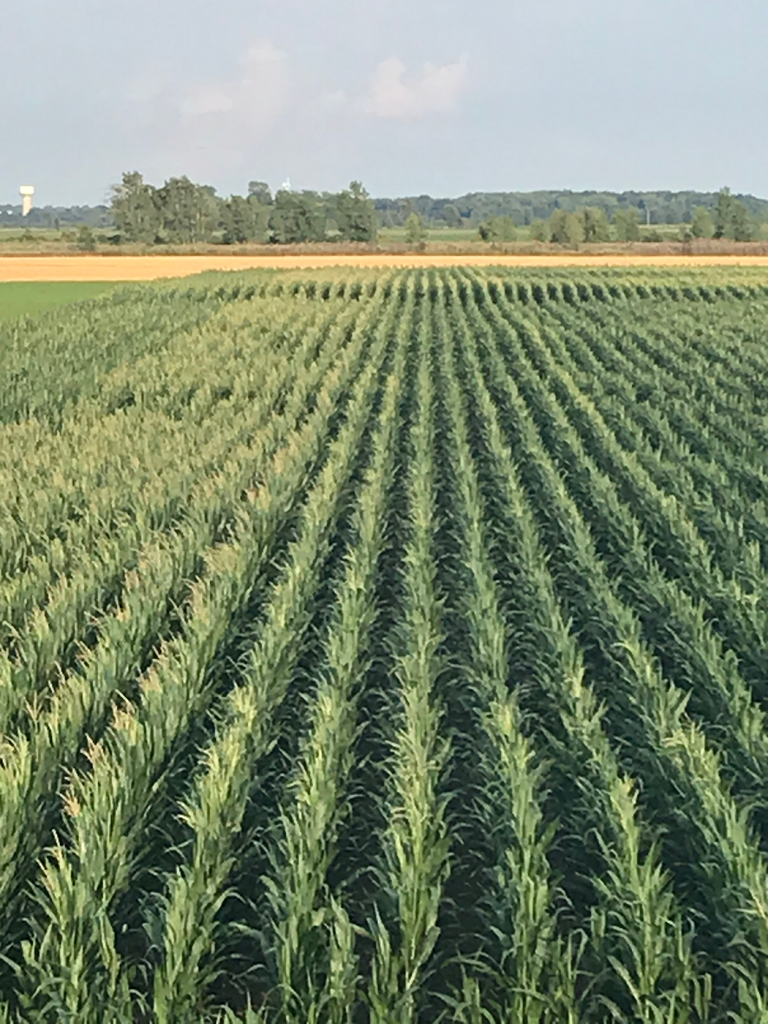
Corn is tasseling now across much of the province (VT stage). Tassel emergence with silks starting to show is ideal. As the tassel emerges the pollen starts to shed. In areas that have received little rain (some regions of eastern Ontario and the far northwest), silk emergence may be delayed as the plant is conserving as much moisture as possible. In certain dire situations, silking may not occur or last very long due to severe drought. If the tassel has emerged with most of the pollen shed occurring before silk emergence, poor pollination may occur resulting – in a poor kernel set on the ear.
Each silk that emerges is connected to a potential kernel within the husk. When one silk is emerged from the corn husk across 50 per cent of the field, the R1 stage has begun. Complete silk emergence can take four to eight days once the first silk appears. If the silk is pollinated, the silk stops growing; if it does not get pollinated, the silk will continue growing for up to 10 days.
Recent weather in the southern region has been ideal for silk channel infection by gibberella, which can cause DON toxin accumulation on the grain. Ideal temperatures for gibberella infection are in the 27° C to 28° C range. For those fields that are susceptible to DON, a fungicide application may be advisable in areas where the weather received during pollination is warm and continual wetness has occurred. Further DON production will also be determined by the environmental weather conditions received during grain fill.
There are a few products currently labelled to suppress gibberella and fusarium ear rot. These are the diseases that are the precursors to the DON toxin. Recommended products from Pub 812 – Field crop protection guide page 41.
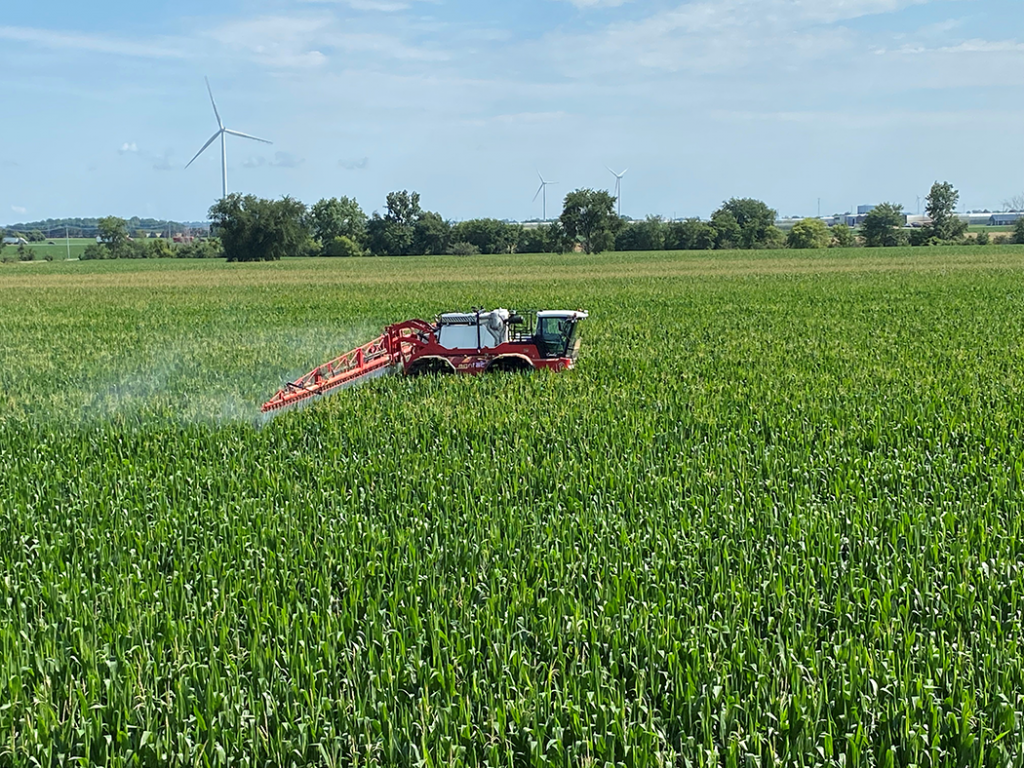
Please read and follow the label for proper timing and application methods. And if you are planning on applying, get your name on the product as quantities are limited. Albert Tenuta, field crop plant pathologist with the Ontario Ministry of Agriculture, Food and Rural Affairs (OMAFRA) is working on trials that look at sprayer systems and nozzle configurations by evaluating both spray coverage and a chemical tracer at the silks, the initial results were highlighted in a recent article in Ontario Grain Farmer.
If you are applying for gibberella/fusarium management please also consider good leaf disease suppression as well in the product applied, as leaf disease can also be a large yield robber.
In some areas it has been so wet, with large amounts of rainfall, fields are too saturated for ground application- aerial application is an option in some cases. Other areas received hail damage in recent storms – a fungicide may be advisable to help suppress leaf and stalk disease.
Western bean cutworm (WBC) adults are being found in traps and eggs masses are being found on leaves. The western bean cutworm factsheet, Scouting and Management in Field Corn, states “when there is an accumulation of five per cent of the plants scouted with fresh egg masses or small larvae over a two to three week scouting period, threshold has been reached. For example, if during the first scouting trip two per cent (two out of 100) of the plants have egg masses on them, then five days later during the second scouting trip there were three per cent (three out of 100) of the plants with fresh egg masses, then threshold has been reached.”
Management of WBC should wait until peak flight, which according to the OMAFRA trap networks is yet to come. For more information on the pest, scouting, and control, visit Field Crop News. WBC larva can feed on the corn cob affecting yields, feeding can also increase the risk of DON mycotoxin development, which is a serious concern.
Soybeans
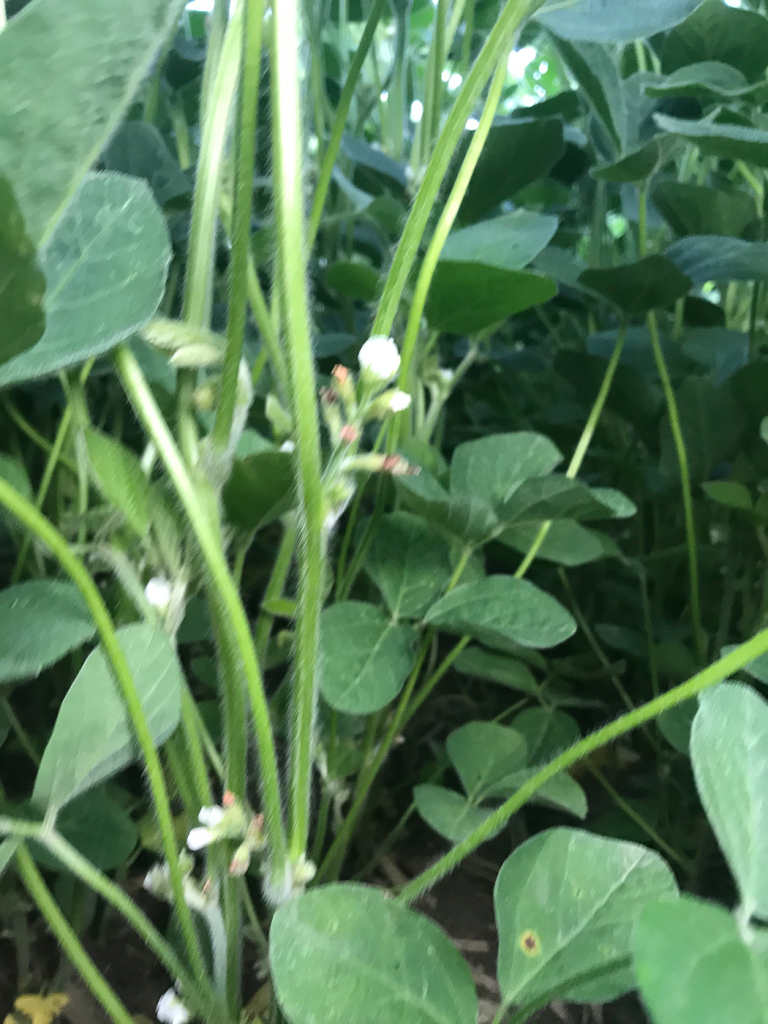
Many fields have reached the R2 (full bloom) to R3 (beginning pod) stage. Diseases are a concern, in areas that have had ample amounts of moisture, as canopies are very lush. The wet, humid days have created the perfect environment for diseases such as white mould. Sporecaster is a great app that you can download and use to assist with making management decisions for white mould in soybeans.
In areas that have received too much moisture, some soybean fields have turned yellow, and plants have died due to not enough available oxygen. In other areas, soybean plants are burning up from drought.
Areas of eastern Ontario have seen high aphid pressure and are taking action when numbers are at threshold and climbing. Look here for more information on threshold levels and when to spray.
There are various diseases and pests to be on the lookout for this summer. Learn more about hot topics this summer in our recent #GrainTalk Farmer Forum.
Wheat
Wheat harvest is at the halfway mark across the province. Moistures range from 14 to 18 per cent. Some fields are being harvested at slightly higher moistures and being dried to limit the chance of sprouts occurring or increasing. It is always a good idea to take a sample into the elevator if there are any questions around quality. Discuss with the potential receiving elevator(s) what options are available if the sample does receive a downgrade.
Click here to review the primary grade determinants table for Eastern Soft Red Wheat.
Some wheat fields around the countryside may appear to have a black, sooty mould on the plant. This is mostly caused by the recent rains and humidity. Fields that were killed by drought or disease may be seeing more of this mould in-field. Generally, this mould should blow out of the combine during harvest although sometimes the mould can infect the grain and cause some quality impacts.
Mildew is also a concern with the weather patterns we have been experiencing. It can develop on mature kernels when there is excess moisture. Mildew damage can, in some cases, warn that sprout damage may be present.
After wheat harvest is a great time to soil sample fields for nutrient content. Soil sampling falls under good 4R nutrient management. View our recent webinar on 4Rs.
If you are struggling with mental health due to the stress brought on by this challenging growing season, please reach out for help.
July 16, 2021
TASSEL EMERGENCE IS occurring in the corn crop; if it is not, it will be very shortly in most fields. Pods are forming on soybeans, with fungicide applications occurring in fields that are at risk of white mould. Wheat harvest is underway in some areas across Ontario. Recent weather has certainly thrown a curve ball at harvest for everyone. With delayed harvest through this wet period, farmers are also dealing with lodged wheat slowing down their harvest pace. Continued wet conditions are creating opportune environments for many diseases to take hold in all the crops.
Corn
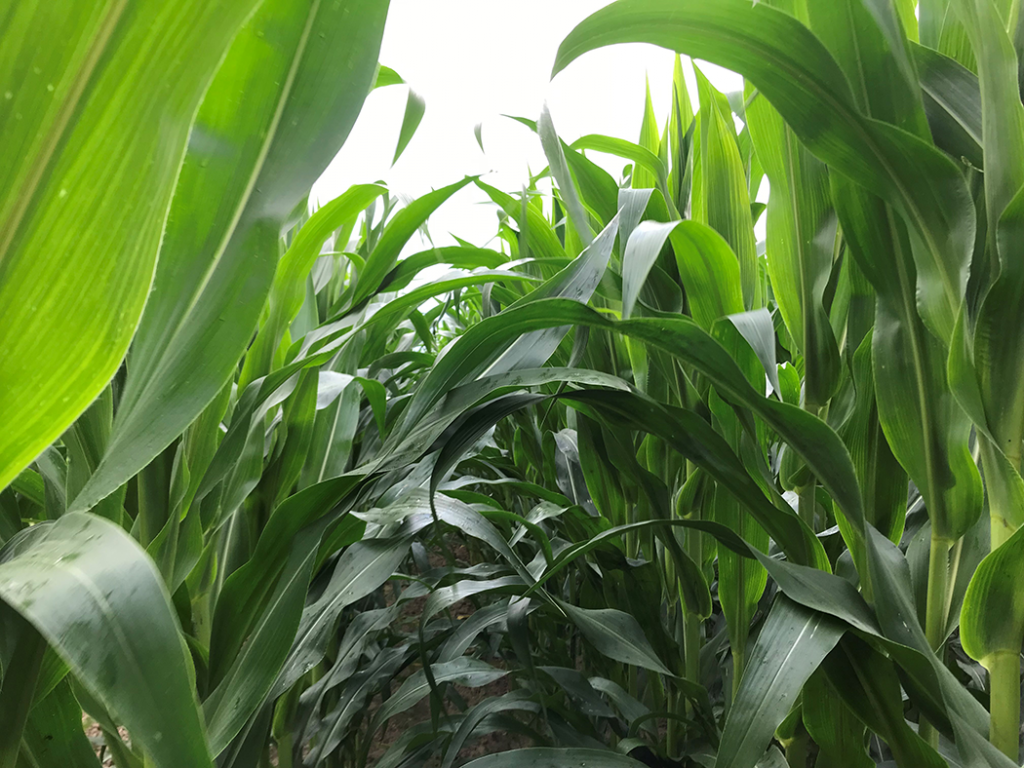
Corn has really jumped in height over the past two weeks. With ample moisture received the corn is stretching out.
Tassel emergence (VT stage) is occurring on the early planted crop, with the majority of acres tasseling over the next week. The silks are emerging a little ahead of pollen shed this year where there is no moisture stress. In drought years, we would see silks emerge just after tasseling as the plant is conserving moisture under stress. This year, we have ample moisture at pollination and will see silks emerge earlier and will be a bit longer as they will keep growing until the pollen grains have made their way down the silk channel to the ovule at which time pollination occurs and silks cease to grow.
Pollen shed from tassels can occur over several days. Pollen shedding is dependent on the environment and the genetics of the corn hybrid. Some plants will shed a little each day for three to five days while other plants (late plants) with smaller tassels may shed quickly in fewer days as they may be under more environmental stress (hotter temperatures and limited water availability, competition).
While you might wish for cool, moist conditions for pollination and grain fill, those same conditions that prolong silk and pollen viability also are the ideal conditions for Gibberella ear rot (aka pink mould) and lead to DON mycotoxin production. Find out more here.
Many different ear disease infections can occur at silking time, as silking is the time when the ear is exposed to pathogens such as Fusarium and Gibberella. Depending on weather conditions and the spores in each field, ear disease development begins at the pollination stage. Infections can also occur from other ear damage from insects, animals, or hail. Which ear disease takes hold will be dependent on what spores are in the field and what weather conditions are ideal for those spores during and after infection. It is all about timing.
Corn, in general is looking exceptional, it is important to keep that potential for high yields high. Fungicides may be applied for plant health and/or for ear health. For the most suspectable situations, farmers will be looking to protect their ears with a fungicide application at the silking time, in an attempt to keep DON levels low. If weather patterns look threatening, or if a highly susceptible variety is being grown, it will be more likely for an application to be made. Refer to label instructions for the best application time to help reduce infection risks.
Along with the heat of the summer comes scouting for corn rootworm. The ideal timing to scout for damage in corn is July until early August. Find out what fields to target first for scouting, what to look for, and what to do if you see damage in this recent Ontario Grain Farmer article.
Soybeans
Soybeans are now in the R2 to R3 stage. The R3 stage is classified as when there is a pod formed that is at least 3/16 inch long (but less than 3/4 inch long) at one of the four uppermost nodes on the main stem with a fully developed leaf. R3 can last anywhere from five to 15 days.
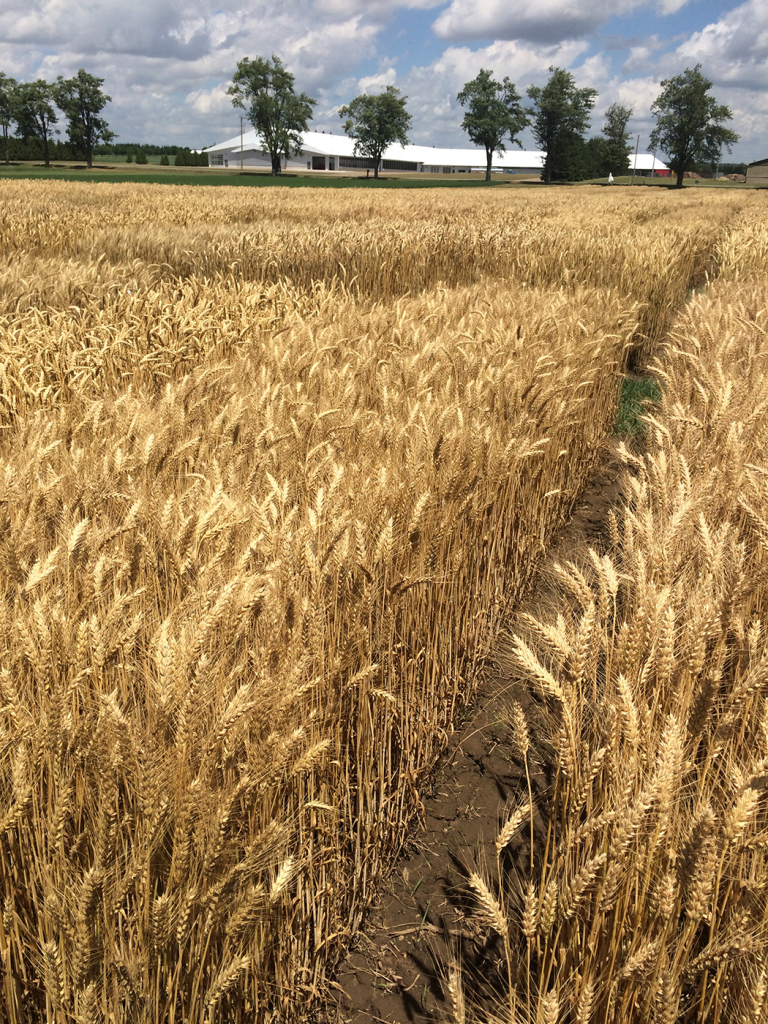
With the heat and moisture, white mould may be forming in some areas. Those who applied a fungicide might see less incidence. Be sure to be on the look out for it in fields, scouting tips can be found here.
Wheat
The end of last week into the beginning of this week saw wheat harvest hit and miss between the rain showers. Moisture levels reported ranged mostly around 15 to 17.5 per cent, with some fields starting around 20 per cent. Yields are good, but there is a threat of test weight losses and yield reduction if this crop sits out in the field too long.
With lots of rain and humidity it is worth taking a walk through your wheat fields that are mature and ready for harvest to look for sprouting and disease pressures and prioritize your harvest to keep the quality good. Separate grain that could lower your wheat grade.
Now is also a great time to be selecting cover crops to plant after wheat harvest is complete. Use the Midwest Cover Crop Selection Tool, which uses research supported by Grain Farmers of Ontario, to help select the best cover crops for your operation.
July 9, 2021
WINTER WHEAT HARVEST began in the southwest over the past week. Good yields and quality were reported before the rains started. Lodged wheat will slow down some of the harvest over the coming weeks as it is slower to dry and slower to harvest.
Corn has been growing rapidly with adequate heat and moisture. Early May planted corn at V12 stage has only four more leaves to unroll before the tassel emerges. We will expect to see some tassel emergence and the beginning of pollination within the next two weeks.
Soybeans are at the R1 to R2 stage of flowering with fungicide applications beginning to occur. Crop conditions are variable across the province with some areas looking good and others that received excessive rain.
Corn
Corn will be tasseling over the next couple of weeks. Tasseling marks a shift in the plant from vegetative growth focused on leaf, stalk, and root growth to reproductive growth where the plant focuses on producing grain. Pollen from the tassel will not begin shedding until the tassel is fully emerged, and tassels typically begin releasing pollen roughly two to three days before the silks emerge. The entire tassel does not release pollen all at once, but sheds from different areas of the tassel for several days, ensuring that pollen is available for optimum fertilization via the silks.
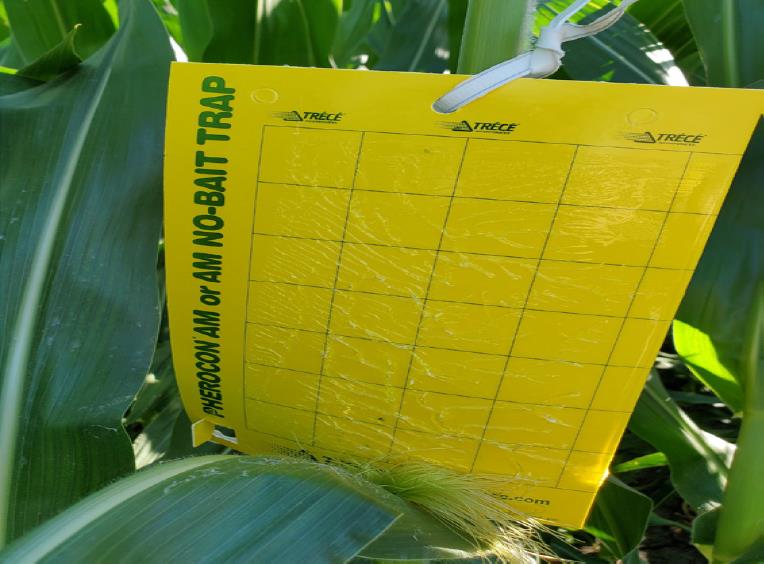
With corn pollination just around the corner, corn rootworm (CRW) traps need to be set out for corn rootworm monitoring. Tracey Baute, field crops entomologist with the Ontario Ministry of Agriculture, Food and Rural Affairs (OMAFRA), is still looking for trap sites, if you are growing corn this year, in particular continuous corn, we are asking that you consider putting up a trap, and monitor that trap, to track potential CRW populations in your fields.
Grain Farmers of Ontario is funding a portion of the traps and traps are free. If you are interested, email tracey.baute@ontario.ca.
For more information on the trapping network and protocols visit here.
For more information on the pest in general, read our Agronomy Alert on corn rootworm Agronomy Alert on Corn rootworm and for a more in depth look at scouting read our recent article.
Tar spot in corn has recently been found in Elgin County. Tar spot is a disease that spreads quickly and can be very detrimental to yields. Farmers need to be vigilant around the discovery and treatment of this disease. In 2020, tar spot was found in Essex, Chatham- Kent, Lambton, and Middlesex. A map with dates of tar spot identification via county is available. These and surrounding counties should be actively scouting for tar spot. For more information on this new to Ontario disease, read our Agronomy Alert.
Soybeans
Soybeans across the province are in the R1 to R2 stage. R2 is full bloom, where there is an open flower on one of the top two nodes on the main stem. Plants will typically stay in the R2 stage for eight to 12 days at which time small pods will begin to form, transitioning the soybean into the R3 stage. In northern Ontario, replanted soybeans are also at the R1-R2 stage but in need of some moisture. In areas that have received excessive rainfall in the past two weeks, signs of wet plant roots are showing as the bottom leaves turn yellow, some areas with newly formed ponds have dead beans. Excessive moisture is creating uneven fields as low areas and compacted areas are not able to achieve proper gas exchange in the root zone. Expect disease pressure to significantly increase in a short time frame.
There are various diseases and pests to be on the lookout for this summer. Learn more about hot topics this summer in our recent GrainTALK Farmer Forum.
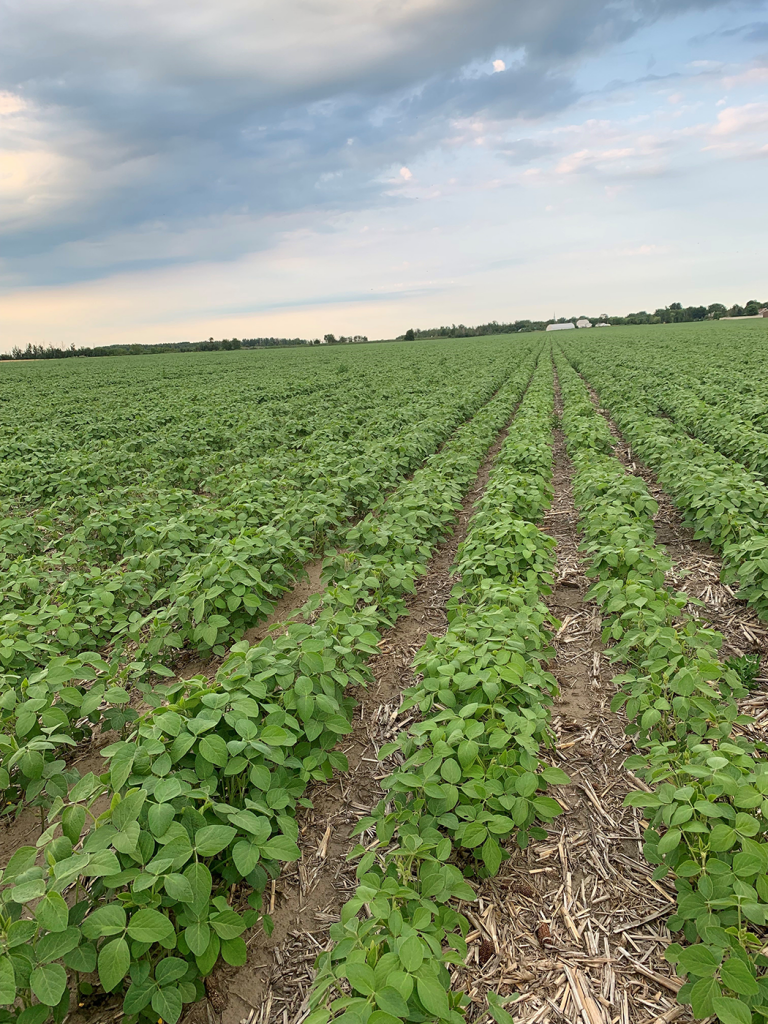
Fungicide applications are occurring or will be shortly if farmers choose to do so. Farmers are applying fungicides to help manage disease and potentially increase crop yield. Many fungicide applications are to help control white mould which can affect the yield of soybeans. Certain varieties are more prone to infection as are fields that were planted early, have a narrow row width, and those that have high plant populations. More information on white mold can be found via the Crop Protection Network, which Grain Farmers of Ontario supports.
Grain Farmers has developed an app with OMAFRA called Pest Manager which allows you to identify, map, and find integrated management options for common weeds, insects, and diseases in corn, soybeans, and cereal crops. Any pesticide use information in the app is specific to Ontario only and users should always read the product label prior to use.
With the early wheat harvest, double crop soybeans are a common conversation in some areas. If aiming for double crop soybeans, seed supply on early season beans will be needed. The date of wheat harvest and the filed location will determine a lot. Aim for seed maturity that is at least one full maturity group shorter but check with your seed dealer on what they suggest and what is available. Seeding rate should be increased to at least a population of 250,000 seeds per acre. Planting date should be considered, looking at frost dates, as the yield potential will drop considerably if soybeans are planted too late; early to mid July planting dates are ideal, be sure that the soybeans are going into good conditions. July 10 is a good date for planting, maybe July 20 in the deep southwest, but it is a large risk at any date; the soybeans might yield, or they might not. The management of straw is critical, be sure to spread straw evenly. If you are considering baling, realize that the time spent baling might keep you out of the field planting for a couple of days. If you do plan on double crop soybeans, plant to moisture- up to 3” in July as they will push through. If there is no moisture at that level aim for 1” planting depth and hope for rain.
The need for weed control in double crop soybeans will be less – in theory one pass would still be needed to control weeds. Most annual weeds emerge during May and June. If double crop soybeans are planted in July, weed pressure should be considerably less. Limit the investment in weed control as the chance for good soybeans is less likely with much relying on the weather cooperating for a good yield and harvest so late in the season.
Cereals
Winter wheat harvest has begun in the southwestern end of the province. In areas that are not quite at harvest, the wheat is still in the grain fill period. Over the past couple of weeks there has been some heavy winds and rains which impacted grain standability, with many wheat fields being impacted in some way, particularly to the north and west of London, either due to the overlap on nitrogen, high fertility fields, or those with varieties with low standability. As harvest approaches, monitor fields closely as the lodged areas are at a greater risk of wet grain and poor grain quality. When harvesting lodged fields, combining in once direction against the wheat can help. It will be time consuming, but worth the commitment. Be sure to adjust combine settings to achieve optimum potential. And make sure bearings are well greased, check bearing temperatures and clean chaff away from moving parts and engines, to limit the chance of combine fires.
If harvest is still awhile away for you, watch this webinar on harvest prep and maximizing your combine’s efficiency.
According to the Canadian Drought Monitor as of the end of June, Ontario’s main growing regions were rated anywhere from abnormally dry to severe drought. More can be found here.
June 25, 2021
IT IS THE tale of two crops in Ontario this week. One region has received timely rains and the crop is looking fantastic, in the other region, missed rains have resulted in the opposite with crops under severe moisture stress. Trouble has been experienced in the dry regions – from wheat fields being burnt off from drought, to limited crop growth as less than one inch of rain has been received in the last seven weeks. The forecasted rain this weekend for these droughted areas will be a welcome relief for the spring seeded crops but a bit late for the winter wheat on porous soils.
Corn
Corn is looking great in areas that received rain. Overall, across the province rain has been very spotty, with some fields showing the imperfections of planting by the lack of rain.
Corn across the province is in the V5-V9 stage. By about the V5/V6 stage (five to six visible leaf collars, or seven to nine full leaves) the tassel is initiated along with the harvestable corn ear. At around the V10 stage, if you remove the leaves from the stalk, including the leaf sheaves, you should be able to see some identifiable ear shoots! Now is the time to not cause any plant stress as it will affect the ear development.
Number of kernel rows are determined on the main ear shortly after V5 to V6. Number of kernel rows is largely driven by plant genetics (maximum row number) but is influenced by the environment.
There have been some reports of sulphur deficiency in corn which are showing up on knolls, etc. A cool spring along with prolonged saturated soils can really slow down the microbial activity and breakdown of soil organic matter which releases sulphur. Sulphur deficiency is characterized by a pale yellowing with veins remaining green on the new leaves on the plant. It might be worth considering future sulphur fertilizer applications on corn fields, similarly to how sulphur is applied to other crops.
Soybeans
Overall, soybean fields are looking good, with some fields canopying. This past week’s cooler weather has slowed growth, but soybean plants can be found in the V6 (six trifoliates) to R1 (beginning bloom) stages. Flowering begins on the third to sixth node of the plant and continues up and down the stem, and then to the branches.
Excessive rains in Essex County earlier this week created some water ponding. With excessively wet soils, keep an eye on root diseases, such as rhizoctonia and fusarium, affecting some of these fields. Tolerant varieties should give good defense, but standing water will affect these plants. More information on identifying these two rots can be found here.

Fungicide timing is approaching for white mould control. The key to getting the most out of fungicide applications is timing. Risks for white mould include the field history, if there is a known history of white mould then the chance of it reoccurring is high.Variety, row spacing, plant density, and how quickly the field will canopy all factor into the likelihood of infection. Weather patterns will also help determine the risk. When it is foggy/humid, and moisture is on the plant most of the day, there will be a higher risk of white mould. The Sporecaster App can help you determine your field’s risk level. Fungicides can lower the severity of infection, however timing is critical. Timing of application ranges from R1 (single flower on the main stem) to R3 (pod on the main stem). Be sure to speak with your agronomist for optimum timing and product selection, always follow label recommendations.
Soybean aphids are being found in some areas across the province, currently at low levels. Typically, aphids found earlier in the season will build up populations through the year. Although weather can alter the population, more importantly is the population of beneficial insects such as ladybugs. If you see aphids, also take note of the beneficial insects. The “Aphid Advisor” app is a great resource for identifying if action is needed.
Cereals
Winter barley harvest will begin in the next week or so.
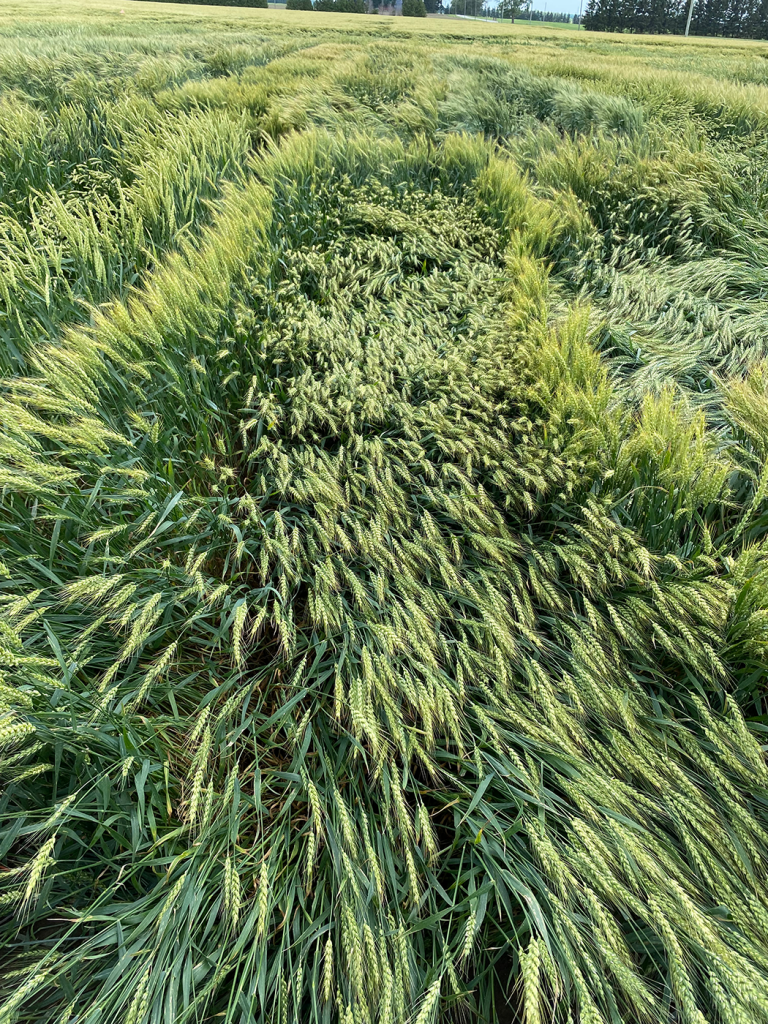
Some lodging in winter wheat fields has been reported this past week due to winds and heavy rain. There are also reports of winter wheat being completely burnt off due to a lack of rain in the Bruce, Grey, and Durham regions. In winter wheat fields that were not sprayed with a T3 fungicide, scouting should be taking place to access levels of fusarium infection in fields. If high rates of infection are noted, harvest those fields first.
Spring cereals are heading out right now. Be sure to scout for stripe rust as it is showing up in some fields. Be sure to keep an eye out for it in your field, be aware of pre-harvest intervals if spraying is warranted.
Cereal leaf beetles are being found in fields. If you do see cereal leaf beetles, the Ontario Ministry of Agriculture, Food, and Rural Affairs (OMAFRA) is asking that you collect them for their survey. More information can be found here.
Cereal aphids are also being found which can cause barley yellow dwarf in wheat. You can use the Cereal Aphid Manage App to help with your decision on whether to take action. Be on the look out for these as you are scouting.
Tours of the Ontario Cereal Crops Committee earlier this week in Zone 1 showed that we have great potential in this year’s crop in this region. Learnings from the trials showed that the earlier planted trials show greatest potential. The later planted locations showed less heads and lower overall plant stands. At the Woodslee site, fusarium was noted and we were able to see the difference in genetics as well as the fungicide applied with intensive management compared to the unsprayed. In Zone 1 trials, heavy rains and winds also played with the wheat sending a few varieties closer to the ground. Interesting data will be coming out of the trials this year, with maybe some yield breakers as the rain came just in the nick of time for this zone. •























